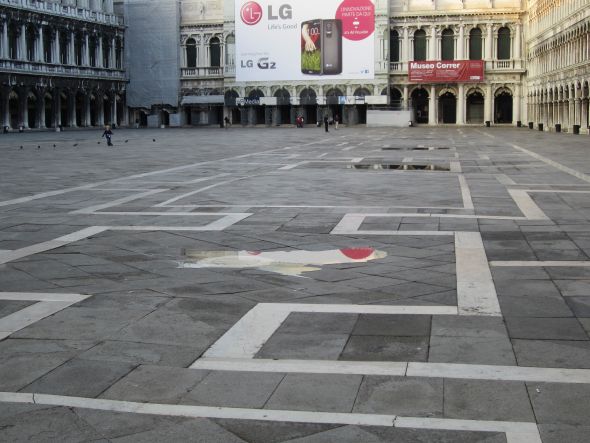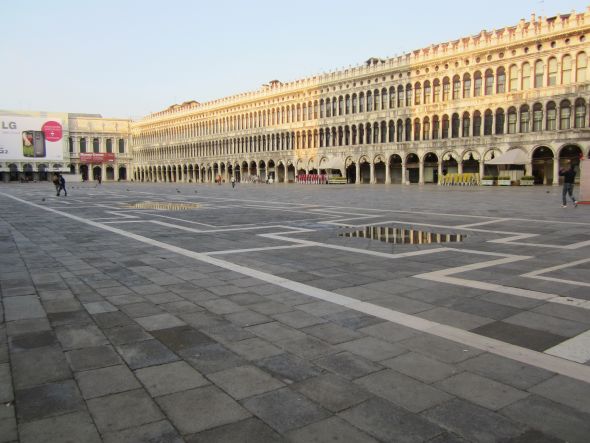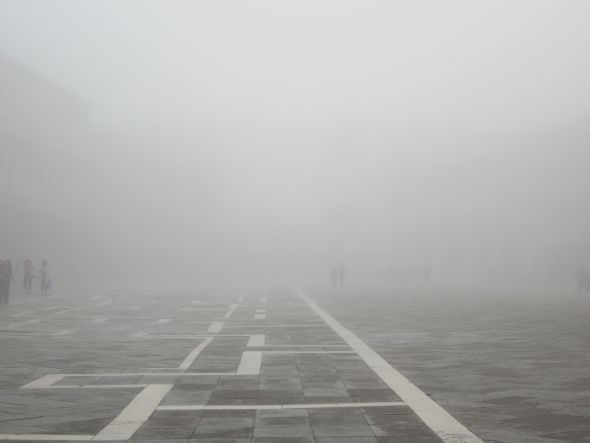I want everyone to stop for a moment and think of Audrey Hepburn. Yes, one of the most divine women ever to set foot on earth. Just writing her name is like inhaling a waft of moonflowers and heliotrope from the Isles of the Blest.
Now I want you to imagine her — just for a second, because this hurts — becoming old, neglected, and feeble. Not demented, just left to deteriorate at random. You know: The soup stain on the blouse, the dirty hair, the shuffly slippers instead of shoes, the drooping slip, the general all-purpose “Just don’t care anymore, can’t be bothered, nothing matters anyway. What pile of unopened bills on the kitchen floor? What half-eaten cans of tuna in the laundry basket? A mouse in the refrigerator? Is it alive?”
Now I want you to stop for a moment and think of Venice.
Now put the two pictures together. Not good. Not good at all.
I hinted in my last post at a certain laissez-faire atmosphere which has taken over what I still am determined to consider the Audrey Hepburn of cities. Over the years, signs of distressing degradation have been noticed, and even reported to the authorities — each sign existing in its own little capsule in the municipal consciousness, just as each sign of personal neglect can be passed over by benevolent or apathetic eyes. Each, of course, explained or excused because no ghe xe schei.
Then suddenly the total of them all reveals itself as appalling.
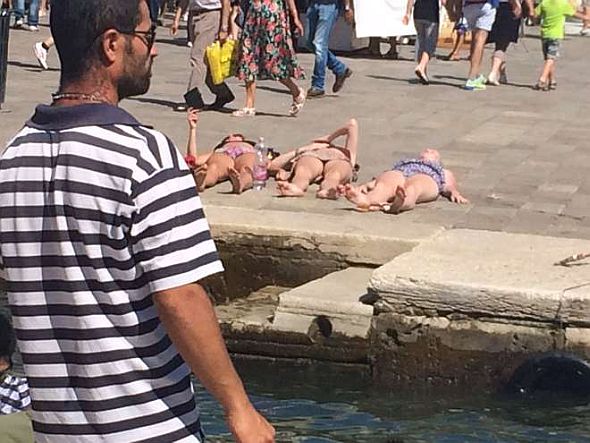
This revelation seems to have hit a lot of people lately, if the Gazzettino is anything to go by. And yes, great lamentations continue to rise from the Venetians concerning the tourists. But if tourists are the perpetrators, the municipal non-authorities are the enablers.
First, the tourists. When I use the word, I’m not referring to their quantity, which is distressing though not difficult to understand, but their quality, which utterly bewilders me.
Yes, of course there are millions of wonderful tourists here all the time. And I don’t want to get into an arm-wrestling match over percentages, or what constitutes “quality tourism,” or the God-given universal human right to come to Venice whenever you want.
But I have to say that I do not perceive a human right to come to Venice to DO whatever you want.
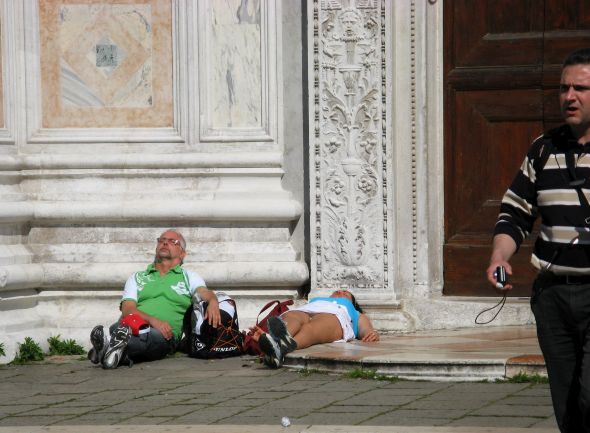
Every few days some novel behavior appears which the star of the story inexplicably considers just fine, behavior which in their own city is probably regarded as offensive and possibly also illegal. Here the same behavior is also regarded as offensive, and is often illegal, and yet Venice, especially in the summer, and especially this summer, seems to attract a type of tourist who thinks that former Queen of the Seas is more fun than the locally-much-reviled Disneyland, although the comparison isn’t very useful considering that the Magic Kingdom is more strictly run than your average penitentiary. I mean that as a compliment.
Graffiti-sprayers and sun-bathers in the Piazza San Marco are no longer any special big deal, repulsive as they are. But this year has kicked it all up a notch. There was the Indian family which hunkered down in the Piazza San Marco to cook lunch on a camp stove. The man who decided to beat the heat by stripping down to his underwear, blithely wandering the streets in his Jockey shorts, or the European equivalent thereof.
A young couple, all tuckered out, who spread their towels on the street in a nice patch of shade and lay down to sleep. A man who decided to scale the Doge’s Palace, demonstrating a free-climbing skill that would have been admirable if he hadn’t been clinging to pieces of marble and statues hundreds of years old.
A tightrope walker who strung his cord between two lampposts along the Zattere. Carnal knowledge on the Scalzi bridge.
Do these people think that it’s Carnival here all year? Did they come all the way to Venice just to do this, or are they merely responding to some sudden impulse? Or do they intuit, by some imperceptible herd sensitivity, that Venice has become something like homeroom with no teacher, all the time?
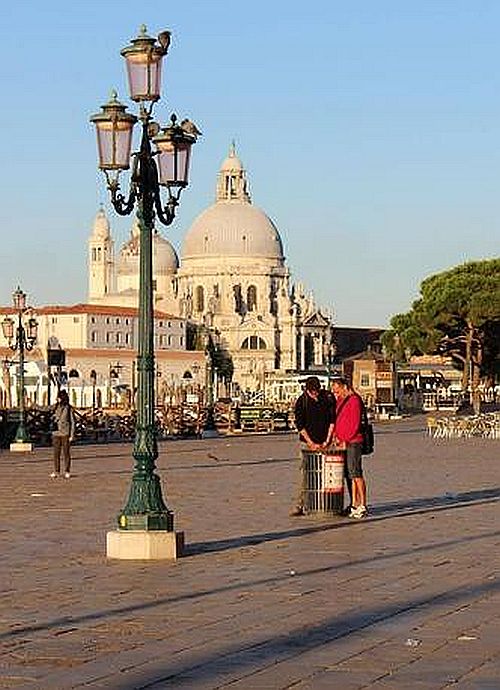
Now comes the latest: Two male visitors in the Piazza San Marco whose bursting bladders brooked no delay. So they relieved themselves into a garbage can. As in many of the above-noted cases, it was broad daylight.
Much of this revolting behavior is something you’d expect — or not be surprised — to see on the Bowery, Skid Row, the Tenderloin, or whatever is the current term for the devastated section of your city.
But this is not them. Nor is it — despite the sun and water and boats — Panama City Beach on Spring Break.
This is a three-square-mile World Heritage Site. It’s more like the Louvre, with sun and water and boats.
So if whatever you’re about to do would be disgusting or ridiculous or rude in the Louvre — or even in Horse Hoof, Kansas, or especially in the much-maligned Disneyland — it would be likewise here.

So much for the tourists.
Yet, as the always perceptive Davide Scalzotto noted in a brief essay in the Gazzettino, if the city has begun to look like a slum (I paraphrase), people will act as if it’s a slum. I believe there are important studies which support this statement. I won’t start a list here of the dreadful deterioration to be seen just about anywhere because it’s too depressing and also because it would make anybody want to scream.
Hardly any money has been spent over the past decade or more on maintenance, let alone improvement, and now we know why. It’s because the city fathers were pulling out the money for MOSE through virtual pneumatic tubes for their own purposes. And the state funds that come via the Special Law for Venice, which was instituted in 1973 specifically to finance measures to protect the city and its environment, are always too little, and too late.
Are there police? Of course, but not nearly enough. Are there laws? Of course, but probably too many. Considering that it’s impossible to enforce them all, they get enforced on an as-needed basis. No wonder the once Most Serene Republic has come to resemble Head-Smashed-In Buffalo Jump.
But let’s say somebody gets arrested — it does happen, though it isn’t always, or even usually, a tourist. Not long ago, we read about a crippled beggar well-known around the crowded streets of Venice and the beaches of Jesolo, just across the lagoon. Hold your sympathy. The story had to do with the fact that at quittin’ time the homeless, 47-year-old Romanian straightened up, brushed himself off, and briskly walked toward wherever he was going that night. When an angry citizen’s photograph was published — the lame walk? The blind see? Is it, in fact, a miracle? — the beggar was hauled in and charged with…. what? Offending public decency? Exploiting the public’s natural compassion? Faking it? What crime, exactly, had he committed?
None. The judge ruled that it is not against the law to beg, even if in the process you callously counterfeit a pitiful condition to earn lucrative sympathy. The mendicant paid an administrative fine, and the judge gave him his cane back.
So: There is no law that forbids a person to present himself as something he is not. I guess I already knew that. We had a mayor who presented himself as honest, but he was not. He was sentenced to four months of house arrest, but his crime wasn’t having pretended to be honest, but for having taken bribes. Ergo, why should somebody be punished for pretending to be a cripple, staggering along, doubled over, supported only by his trembling cane?
So we could all start faking it and still be fine. I know people who pretend to be intelligent, or caring, or lots of things they’re not. I could walk around pretending I was Elaine Stritch and I’d never be arrested, at least not until I started belting out “I’m Still Here” on the street.
Here is the YouTube link: http://youtu.be/CFzmVYNItjU
I started with Audrey and I’ve ended up with Elaine. My God: It’s the story of Venice in two names. Maybe “I’m Still Here” ought to be the new national anthem of Venice.
Except that it shouldn’t have to.
My next post, barring some unforeseen calamity, will take us back to happier topics. I’ve had more than I can take of all this tsuris.


